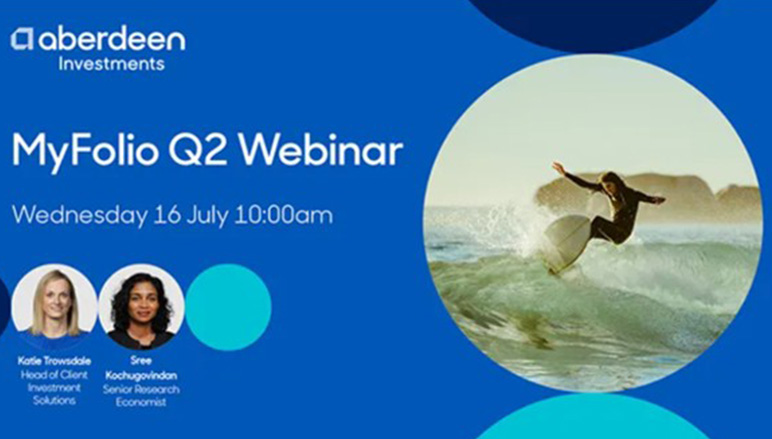HUB EXCLUSIVES PANEL DISCUSSION 2023 – THE CHANGING ENVIRONMENT FOR MULTI-ASSET FUNDS
Panel discussion, hosted by Cherry Reynard, with:
Daniel Hughes, Premier Miton Defensive Growth Fund Manager, Premier Miton Investors
Olivia Geldenhuys, Investment Director, Schroders
Mark Lane, Senior Investment Manager for MyFolio Sustainable Funds, abrdn
In the post financial crisis period, low interest rates and quantitative easing lifted all boats. It was both an easy time for multi-asset managers – because returns from financial assets went up – and a difficult one – because it was very difficult to beat a portfolio of tech stocks and long-dated government bonds. Today, the environment looks very different, with inflation persistent and interest rates far higher. How are multi-asset funds adapting?
The new environment has certainly been a shock for those investors that assumed ‘the great moderation’, with low interest rates and inflation, was here to stay. Daniel Hughes, manager on the Premier Miton Diversified funds, says investors were pushed into higher risk assets, while central banks created the impression that any time there was stress in markets, they would step in and support asset prices.
In 2022, when this didn’t happen, markets became unstuck. Many investors had to adjust to the idea that central banks could be the driver of market volatility rather than a stabilising force. It has taken investors a while to catch up to the new reality.
Mark Lane, senior investment manager for MyFolio Sustainable Funds at abrdn, believes the market is still being far too sanguine about the potential for interest rates to fall back to pre-Covid levels: “There appears to be a narrative in the market that long-term interest rates will drop back down. With inflation at 1.5-2.5%, that might be possible, but the degree of certainty that markets are ascribing to that outcome is too high.
“Rates are likely to settle above the levels we’ve been used to and variability will be higher from here.” He believes interest rates will continue to be difficult to forecast and will be a significant influence on markets.
Olivia Geldenhuys, investment director at Schroders, is equally sceptical that inflation will drop back down again: “Inflation isn’t going anywhere soon, though central banks are trying to get it back down to more manageable levels. We are likely to be at higher inflation levels than we’ve become used to over the past decade.”
Flexibility
Flexibility has been very important in navigating the investment climate over the past few years and will continue to be important as the environment changes. A static allocation to bonds and equities worked well up to 2021, but was a disaster in 2022. Multi-asset managers have had to straddle a low and high interest rate environment.
Hughes says: “We don’t have to hold assets we don’t want to – and the way the bond allocation has shifted over time is an example of that. Pre-2022, we held no traditional bonds, but instead sought similar characteristics through areas such as specialist lending. Today, our asset allocation has shifted back to traditional bonds.”
Most multi-asset managers have made extensive use of alternatives. Geldenhuys says: “It was one of the only areas that had positive performance in 2022 that provided a good bulwark to the volatility elsewhere. We look at them in terms of risk diversifiers and return enhancers, and where we are in the market cycle will determine the balance of our allocation.” She doesn’t see any near-term decrease in volatility, so Schroders multi-asset funds are still tilted toward risk diversifiers.
Positioning today
The bond allocation has been subject to the greatest change for multi-asset managers, with many swooping in to take advantage of higher yields and improved diversification characteristics. Lane, for example, had held short-dated corporate bonds through 2021 and 2022, but has switched that into government bonds as yields have risen.
Geldenhuys believes it is equally important to be dynamic within asset classes as well as between them. She says: “We’ve taken several factor tilts within the different regions. For example, in global equity, we’ve had a tilt towards value. On the government bond side, we have been flexible around duration. Being dynamic within each asset classes is vitally important into achieve our clients’ long-term outcomes.”
Lane says the abrdn team had started to anticipate a change in the interest rate environment as far back as 2020, tentatively adding duration to their portfolios. More recently, the team has also materially reduced the smaller cap area, which they see as particularly challenged: “Within each asset class, we are looking for less cyclical and more robust ways to find exposure to risky assets.”
Hughes and the Premier Miton team take a more devolved approach to their equity allocation, handing much of the granular decision-making to individual equity managers. While this brought out a growth bias in 2020 and 2021, today, it has delivered a more balanced portfolio. “This seems appropriate for the environment we’re in. No-one is sure where interest rates or inflation are likely to end up and there is lot of uncertainty.”
In other words, there is no ‘back to normal’ for multi-asset managers, even with bond yields higher and traditional diversification relationships restored. The current environment will take careful allocation both within and between asset classes.









